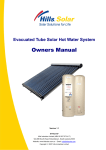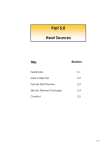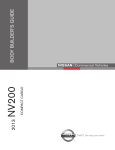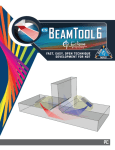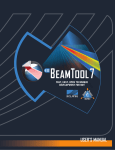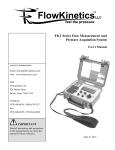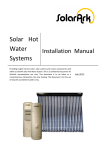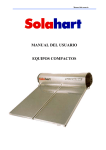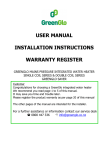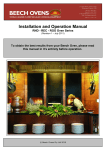Download Installation Manual - Solar Hot Water Parts
Transcript
IMPORTANT Please leave me with the owner! Evacuated Tube Solar Hot Water System Installation Manual Version 5.1 Endless Solar Operations Pty. Ltd. (ABN 64 128 433 205) Unit 1 / 340 Chisholm Rd, Auburn NSW 2144 1300 889 585 www.endless-solar.com [email protected] Copyright © 2013 Endless Solar® Corporation Ltd. Contents Section 1 – Introduction and Important Information ............................................................................. 4 Introduction ........................................................................................................................................ 4 Installation Requirements................................................................................................................... 5 Water Supply................................................................................................................................... 5 Parts Substitution............................................................................................................................ 6 Correct valves, fittings, materials & components ........................................................................... 6 Important safety valves .................................................................................................................. 6 Boosting .......................................................................................................................................... 8 Electric boosted systems................................................................................................................. 8 Section 2 – Installation Procedure ........................................................................................................ 10 Step 1: Planning Your Installation ..................................................................................................... 10 1.1. Hazard Analysis ................................................................................................................. 10 1.2. Customer Wishes and Expectations.................................................................................. 10 1.3. Location of the Collector ................................................................................................... 10 1.4. Location of Storage Tank .................................................................................................. 12 1.5. Gas Booster Installation .................................................................................................... 12 1.6. Unpack and inspect ........................................................................................................... 12 1.7. Damaged/Faulty Components .......................................................................................... 12 1.8. Parts List ............................................................................................................................ 13 1.9. Pump, Controller and Air Vent Assembly ......................................................................... 14 1.10. Evacuated Tubes ........................................................................................................... 14 Step 2: Ground Plumbing .................................................................................................................. 15 2.1. Tank & Booster Installation............................................................................................... 15 2.2. Tank Connection ............................................................................................................... 15 2.3. Gas connections and gas piping (Gas systems only) ......................................................... 16 2.4. Connect power (electric boosted system) ........................................................................ 16 Step 3: Roof Installation .................................................................................................................... 17 1.1. Mounting & Roof Attachments ......................................................................................... 17 1.2. Collector Construction ...................................................................................................... 17 1.3. Roof Plumbing & Insulation .............................................................................................. 19 1.4. Plumbing Connections ...................................................................................................... 19 1.5. Inlet and outlet connection on the collector .................................................................... 20 1.6. Automatic Air Vent............................................................................................................ 20 Step 4 Solar Flow and Return ............................................................................................................ 21 Endless Solar® Installation Manual v5.1 Copyright © 2013 Endless Solar® Corporation Ltd Page 2 of 37 1.1. Copper Pipe ....................................................................................................................... 21 1.2. Insulation........................................................................................................................... 21 Step 5: Solar Pump and Controller.................................................................................................... 21 1.3. Install the Pump Box ......................................................................................................... 22 1.1. Installing Controller Sensors ............................................................................................. 22 1.2. Pump Power Outlet........................................................................................................... 23 The Pump Power Outlet ................................................................................................................ 23 Step 6: System Start-up .................................................................................................................... 23 Step 7: Insert Tubes .......................................................................................................................... 25 Step 8: Post Installation Procedure................................................................................................... 26 Section 3 – Appendices ......................................................................................................................... 27 A. Troubleshooting .................................................................................................................... 27 B. Roof Attachments ..................................................................................................................... 29 C. Adjustable Aluminium Frame ............................................................................................... 30 D. Retrofitting to Existing Hot Water Systems .............................................................................. 33 E. Electric Boosted System Schematic .......................................................................................... 34 F. Gas Boosted System Schematic ................................................................................................ 36 Endless Solar® Installation Manual v5.1 Copyright © 2013 Endless Solar® Corporation Ltd Page 3 of 37 Section 1 – Introduction and Important Information Introduction Thank you for choosing an Endless Solar® Evacuated Tube Solar Hot Water System. This document outlines the principles of installing an Endless Solar® system for residential/domestic hot water applications. Please read this document thoroughly to ensure correct and safe installation of the system. Even though you may have installed other types of solar hot water systems you should read this manual thoroughly. The information provided in this document is Copyright © Endless Solar. This document or its content must not be reproduced in any format. No information in this document may be used for commercial or other purposes unless Endless Solar gives its prior written consent to the intended use. This document provides an installation overview of the Endless Solar Evacuated Tube Solar Hot Water System. Endless Solar is not responsible for any loss or damage to any person or property of any type, whether direct or consequential, arising from the installation or operation of the solar hot water system or any of its components. Endless Solar has made every reasonable attempt to ensure the accuracy of the information provided. The content in this document is provided for information purposes only. Certain information in this manual is supplied by third party component manufacturers, accordingly Endless Solar cannot warrant that all the information is accurate. No claim is made as to the accuracy or authenticity of the content in this document. Endless Solar will accept no liability to any person for the information or advice (or the use of such information or advice) which is provided in this document or incorporated into it by reference. OH&S Disclaimer - Endless Solar is a supplier of components only. Each installation must be covered by the installer’s insurances, commercial terms and conditions and by the applicable OH&S requirements relevant to the type of work being conducted including, but not limited to, plumbing work, work on roofs and electrical work. Endless Solar do not accept any responsibility for any loss or damage to any person or property of any type, whether direct or consequential, arising from the installation, maintenance or operation of the solar hot water system or any of its components. Endless Solar® Installation Manual v5.1 Copyright © 2013 Endless Solar® Corporation Ltd Page 4 of 37 Installation Requirements Regulations Installation of Endless Solar Systems must also be in accordance with: o o o o o o o o o National Plumbing Code AS/NZS 3500.4 AS/NZS 5601 for installation of the gas booster (in accordance with AG 601) Installation Instructions AS/NZS 3000 – Wiring rules Local gas fitting regulations Local plumbing regulations All Government regulations Local Council regulations Any other relevant act or regulation Qualified installer Installation must be completed and signed off in writing by a qualified plumbing professional. Electrical work must be completed by a qualified electrician. The installation company is required to supply warranty for the installation and workmanship. Water Supply Water Pressure The system has been designed to connect to mains water supply of at least 400kPa. Low pressure water supplies, such as gravity feed or rainwater tank supplies may not provide adequate water pressure for the system to operate correctly. It may be necessary to install a household pressure pump to achieve the correct operating pressure. The water supply pressure must be limited to 500kPa. A pressure-limiting valve of 500kPa must be fitted. Water Quality Copper is susceptible to corrosion when high concentrations of chloride are present; therefore, use of this system to directly heat chlorinated pool or spa water will void the Warranty. Chloride levels present in most reticulated public potable water supplies are safe for use in the solar collector provided there is no use of bore waters in the reticulated supply. In areas with “hard” water (>200p.p.m), lime scale may form inside the collector header pipe. In such regions, it is advisable to install a water softening device to ensure the long term efficient operation of the solar collector, and/or use a closed loop for the solar collector. Endless Solar® Installation Manual v5.1 Copyright © 2013 Endless Solar® Corporation Ltd Page 5 of 37 To maintain warranty, water flowing through the manifold header must comply with the water characteristics detailed in the Water Specifications table below. Table 1: Water Specifications Water Characteristic Total dissolved solids Total hardness Chloride Sodium Magnesium pH Levels Electrical Conductivity Level < 600 mg/litre or p.p.m < 200 mg/litre or p.p.m < 250 mg/litre or p.p.m < 150 mg/litre or p.p.m < 10 mg/litre or p.p.m 6.5 - 8.5 < 850 uS/cm Rainwater caught off the roofs of buildings collects carbon dioxide from the atmosphere. The carbon dioxide dissolves in the water producing a weak acid - carbonic acid. Although not strongly acidic it can be corrosive. You should ensure that the rainwater quality is suitable for use with the system. Rainwater supplies must be both strained and filtered before entering the system, as impurities, small particles and debris in rainwater can cause damage to the components in the system. Failure to do this will void the warranty. Parts Substitution Parts and components in the system design must not be substituted or omitted. Compliance with legislation is the responsibility of the installer. Substituting components provided by Endless Solar will void the warranty and may prevent the customer from applying for STCs, grants and other financial incentives. Correct valves, fittings, materials & components It is important to use only the correct valves and fittings when installing the system. The components specified are legally required and/or are required to meet warranty conditions. Important safety valves Solar Tempering Valve A solar rated tempering valve must be installed prior fixtures used for sanitary purposes (e.g. showers and washbasins) where risk of scalding can occur. The installer accepts full liability for non-compliance. The solar tempering valve controls the temperature of the hot water coming from the storage tank to a maximum of 50°C thus preventing serious burns in outlets within the house. This valve is designed to work with the higher temperatures that solar hot water systems can produce. Standard tempering valves are only rated up to 85°C but the solar tempering valve is rated up to 99°C. Endless Solar® Installation Manual v5.1 Copyright © 2013 Endless Solar® Corporation Ltd Page 6 of 37 Non-Return Valve A non-return valve must be installed on the cold water line to the solar storage tank in between the cold water branch to the solar tempering valve and the storage tank. Please refer to system schematics for more information. This ensures that hot water cannot flow from the storage tanks back into the cold water line or into the cold inlet to the solar tempering valve. Pressure Limiting Valve A pressure limiting valve set at 500kPa must be fitted. A pressure limiting valve can protect the hot water tank and other components/appliances that use water by limiting the water pressure that goes into them. Failure to install a pressure limiting valve will void the warranty. The pressure limiting valve should be installed so that it will not interfere with, or unbalance the proper operation of the solar tempering valve or other mixing valves, or affect the pressure balance of hot and cold water at the tap. It is good practice to install the pressure-limiting valve on the cold feed to the house to ensure that both the hot and cold supply have equal pressure. Expansion Control Valve Subject to local authority regulations it is a requirement that an expansion control valve be fitted between the non-return valve and the cold water inlet to the solar storage tank. Note: A separate drain line must be run for the expansion control valve. Copper Olives Do not use plastic olives, as they will not withstand the heat that the collector produces. Only use copper olives as they are designed to withstand higher temperatures. Piping AS 1432 approved copper pipe should be used for the system and be properly insulated using high quality thermal lagging. Keep pipe runs as short as practical to reduce any possible heat losses. The cold water line to the solar storage tank should be the same size or bigger than the hot water supply pipe to the house from the solar storage tank. Important: Do not under any circumstances use plastic piping for the solar flow and return lines, or for PTR valve drains. Insulation It is important that high quality UV protected insulation be installed on all pipe work to reduce heat loss. Please review AS/NZS 3500.4 for detail on the type and quality of insulation you should use for your area. As a general rule, the insulation should have a high R-Value and be suitable for the pipe diameter. Insulation should be UV, high temperature and weather protected. Safe Tray The National Plumbing Code AS/NZS 3500.4 requires safe trays to be installed to all water heaters where, if there is a leak, property may be damaged. Installation of such trays must comply with the Code. Endless Solar® Installation Manual v5.1 Copyright © 2013 Endless Solar® Corporation Ltd Page 7 of 37 Important: Ensure that all components including the tank, pump assembly, valves and fittings cannot cause water damage if there is a leak. PTR Valve An 850 kPa Pressure and Temperature Relief Valve (99ºC, 46kW) must be installed on the solar storage tank. Boosting Each of our solar water heaters has a back up boosting system to ensure that hot water is always available. We design our system so that the sun is always given precedence over the use of purchased energy to heat the water. There is a choice of gas (Natural Gas or LPG) or electricity (mid or bottom element) to boost the water. Electric boosted systems Electric boosted systems contain an electric element inside the tank. Bottom Element Tanks Tanks with a bottom element (the element is located towards the bottom of the tank) can be connected to an Off-peak 1 tariff (night rate); or in cases where Off-peak 1 tariff is not available should be connected to continuous electricity with a timer that activates the element after the sun has gone down. Mid Element Tanks Tanks with a mid element (the element is located towards the middle of the tank) the element to a ‘manual boosting switch’, or any other device that will override the normal operation of the system. Gas Boosted Systems Water leaving the solar system and entering the house will be automatically heated (if required) by an in-series instantaneous gas booster. This ensures that in periods of low solar gain that hot water will always be available. Endless Solar® Installation Manual v5.1 Copyright © 2013 Endless Solar® Corporation Ltd Page 8 of 37 Minimum Flow Rate and Pressure The gas booster operates when there is a minimum of 3L of hot water flowing. The use of water saving tap fittings that have less than a 7.5L/min flow rate or that have restrictors in them can interfere with the operation. To check operation, open the hot tap fully to see if the gas booster comes on. The gas boosters need a minimum of 150kPa water pressure (15.3m head pressure) in order to function properly. If the pressure is less than 150kPa then a water pressure pump can be installed (9.789kPa = 1m of head pressure). Regulator When upgrading from a gas storage tank to a gas-solar system using a continuous flow gas booster check that the gas regulator has been upgraded from 1.375kPa to 2.75kPa otherwise you might experience low water pressure and/or water that does not get heated by the gas booster to the required temperature. Electronic Temperature Controller It is not recommended to use electronic temperature controllers with instantaneous gas boosted solar systems, as their operation is limited due to the stored solar hot water often being hotter than the temperature selected. Location The gas booster is designed for external installation in accordance with Australian Standards. The installation location must meet the prescribed requirements in respect to clearances for the flue terminal for Gas Boosted systems (Refer to AS5601 or local gas fitting rules for specific locations). Important: Before installing the gas booster, check that the gas booster supplied is suitable for the type of fuel being used (eg. Natural Gas or Liquefied Petroleum Gas). Electric Element with Gas Boosted Systems If the solar storage tank for a gas boosted system contains an electric element do not connect it to power. Endless Solar® Installation Manual v5.1 Copyright © 2013 Endless Solar® Corporation Ltd Page 9 of 37 Section 2 – Installation Procedure IMPORTANT NOTE: Do not install the Evacuated Tubes until the system is ready to be commissioned (Step 7). Step 1: Planning Your Installation 1.1. Hazard Analysis Complete a site-specific safe work method statement prior to commencing works. 1.2. Customer Wishes and Expectations Speak with the customer about the installation. Ensure that they understand the installation process and your obligations to meet all of the requirements in this manual. If there are any unexpected problems or additional costs associated with the installation, inform the customer now. 1.3. Location of the Collector Select a roof face with the appropriate direction and pitch that is not affected by shading. Collector Orientation In Australia, it is desirable that the collector should face due North for optimum performance. Important: The sun will run a different path across the sky depending on the time of year. In winter, the sun will be lower in the sky than it is in summer. Be conscious of possible shading from trees and buildings at different times of the year. East or West Orientation: If the collector faces North-East or North-West the performance will decrease by an insignificant amount, and if angled directly East or West the performance will decrease by only a small amount. Important: Do not install the collector so that it is facing south. Positioning the collector on a South facing roof can be achieved using a backward facing frame to correctly pitch the collector in a Northerly direction. Endless Solar® Installation Manual v5.1 Copyright © 2013 Endless Solar® Corporation Ltd Page 10 of 37 Figure 1: Solar Path by Season Collector Pitch Endless Solar Evacuated Tubes perform best when installed at an angle of between 20° and 60° from the horizontal. The optimal pitch is the location’s latitude plus 10° (unless the latitude is less than 10°). Where possible, the Endless Solar collectors should be installed at the optimal pitch. The following table shows the optimal collector angles for the major cities in Australia. If a roof has an angle less than 20°, it is necessary to use the low-pitched roof frame or A-frame to ensure optimal performance. Note: Angling the collector greater than the optimum pitch will give better performance in winter whilst decreasing performance in summer. Similarly, a lower pitch will increase the collector’s summer performance whilst decreasing performance in winter. Note: If the collector is oriented to face East or West (which is an acceptable direction for Evacuated Tubes), you should pitch the collector lower, use a pitch that is 2/3rds of the Optimum Pitch or 20°, whichever is greater. Table 2: Collector Pitch Location Latitude Acceptable Range of Pitch Optimum Pitch (Annual Performance) Optimum Winter Angle* 35° 20 - 55° 45° 61° Adelaide 23° 20 - 43° 33° 50° Alice Springs 27° 20 - 47° 37° 54° Brisbane 35° 20 55° 45° 61° Canberra 12° 20 - 32° 32° 40° Darwin 42° 22 - 62° 52° 67° Hobart 37° 20 - 67° 47° 63° Melbourne 32° 20 - 52° 42° 58° Perth 34° 20 - 54° 44° 60° Sydney *Note: To comply with AS/NZS 3500.4, collectors must be installed within 20° of the latitude. Shading Analysis Collectors should be located so that shading does not occur for at least the 3 hours either side of 12-noon local standard time. Partial shading due to small objects such antennas or a small flue is not of concern. Endless Solar® Installation Manual v5.1 Copyright © 2013 Endless Solar® Corporation Ltd Page 11 of 37 Figure 2: Shading Location of Collector in Relation to the Tank Without compromising the efficient operation of the solar collector, it is important to keep the piping distance between the collector and tank to a minimum. This will aid in reducing heat loss, water flow resistance in the pipe work, as well as keep installation and material costs to a minimum. 1.4. Location of Storage Tank The storage tank should be located as close as possible to the most frequently used hot water outlets (e.g. bathroom or kitchen). The storage tank should also be located as close as possible to the hot water outlet of the collector manifold to reduce heat loss. Note: Installation of the storage tank must comply with the relevant Australian Standards. Tanks may be installed internally or externally. The Endless Solar® stainless steel storage tanks do not require a sacrificial anode; therefore, low eaves do not present a problem. 1.5. Gas Booster Installation The gas booster is designed for external installation in accordance with Australian Standards. For full information, see the Gas Booster Installation Guide supplied with the Gas Booster. Installation location must meet the prescribed requirements in respect to clearances for Gas systems. 1.6. Unpack and inspect Prior to the installation of the Endless Solar System, all components should be unpacked and inspected to ensure they are complete and free from damage that may have occurred during transit. Refer to your invoice and Parts List below for a complete list of components. 1.7. Damaged/Faulty Components You should notify your supplier of any damaged or faulty components prior to installation. Endless Solar® Installation Manual v5.1 Copyright © 2013 Endless Solar® Corporation Ltd Page 12 of 37 1.8. Parts List The Endless Solar System is delivered in a number of packages; the contents of these packages are listed in the following tables and on the supplied invoice. You should notify your supplier of any missing components prior to installation. Collector Manifold Kit Table 3: Contents of the Collector Manifold Box Collector Size Part 20 Tube 30 Tube Nylon Locking End Caps 1 20 1 30 Silicon Thermal Paste 1 1 Compression Fitting 20C x 15M 2 2 Roof Attachment Straps 6 6 Rubber Mounting Pad 9 9 Bottom Track 1 1 Front Track 3 3 Attachment Plate 6 6 Bolts & Nut Lock Assembly 12 12 Manifold Storage Tank Inspect the water storage tank to ensure casing is not damaged. Inspect all ports. Inspect the PTR Valve to ensure that it is not damaged. Note: The tank is supplied with a PTR valve and sensor well which may be stored inside the thermostat cover and will need to be removed prior to installation of the tank. Endless Solar® Installation Manual v5.1 Copyright © 2013 Endless Solar® Corporation Ltd Page 13 of 37 1.9. Pump, Controller and Air Vent Assembly The following items are generally packed together in one box. Table 4: Contents of the Solar Control Kit Box Standard Pump Assembly Qty Pump Cover 1 Ball Valve 1 Pump 1 Non-Return Valve (Spring check valve) 1 Flow Control Valve 1 Air Vent Assembly Qty Solar Air Vent 1 Hex Bush 3/8”F x 1/2”M 1 Elbow, 15M x 15F 1 Tee 15F x 15F x 15F 1 Union Compression 15C X 15M 1 Elbow Compression 15C X 15F 1 Controller Qty Controller unit (with tanks sensor attached) 1 Collector Sensor 1 Quick Start and Installation guide 1 Wall plugs with screws 4 Wood screws 2 Screw covers 4 Manual Qty Installation Manual 1 Owners’ Manual 1 1.10. Evacuated Tubes Open the boxes containing the Evacuated Tubes. o Check for Damage o Check Vacuum: Check to make sure the Evacuated Tubes are all intact, and the bottom of each tube is still silver. Important: If a tube has a white or clear bottom, it is damaged and should be replaced. Caution: When inspecting the Evacuated Tubes, do not expose them to sunlight for extended periods of time otherwise the heat pipe will become very hot. This can cause accidental burns and/or damage to packaging - ensure that you close the boxes fully when done. Note: Endless Solar Evacuated Tubes are supplied pre-assembled. There is no need to alter the tube configuration in any way. Do not remove the heat pipe and other components from the glass tube. Endless Solar® Installation Manual v5.1 Copyright © 2013 Endless Solar® Corporation Ltd Page 14 of 37 Step 2: Ground Plumbing 2.1. Tank & Booster Installation Cold Water Valve Assembly The cold water valve assembly must include an isolating valve, a 500kPa pressure limiting valve and a non-return valve. A line strainer and/ or an expansion control valve may be required in some areas. Failure to install a pressure-limiting valve will void the Warranty. Figure 3: Cold Water Valve Assembly The tanks shall be installed so that each unit is accessible for servicing and removal. See AS/NZS 3500.4 2.2. Tank Connection Note: This diagram is for explanatory purposes only refer to the Endless Solar pre-installation guide for exact dimensions and port locations. Figure 4: Solar Storage Tank Ports Endless Solar® Installation Manual v5.1 Copyright © 2013 Endless Solar® Corporation Ltd Page 15 of 37 2.3. Gas connections and gas piping (Gas systems only) The installation requirements of AG 601 apply to all general work & safety requirements, materials & gas piping, installation of gas piping, appliance installation and commissioning. 2.4. Connect power (electric boosted system) Please refer to “Electric boosted systems” on page 8 for information on suitable electricity connections. No Building Flow and Return Line (Ring Main) Conventional building flow and return lines cannot be used in conjunction with solar hot water systems; returning hot water to the solar storage tank will inhibit the operation of the solar collectors. If a hot water circulator is requested, please contact Endless Solar for information on a suitable device. Endless Solar® Installation Manual v5.1 Copyright © 2013 Endless Solar® Corporation Ltd Page 16 of 37 Step 3: Roof Installation Remember: Do not install the Evacuated Tubes until the system is ready to be commissioned (Step 7). 1.1. Mounting & Roof Attachments Zinc or Zn/Al galvanised components should NOT be installed in direct contact with stainless steel, as galvanic reaction between the two metals can cause premature corrosion of the zinc coating and possibly the steel underneath. Use the rubber frame mounting blocks provided. 1.2. Collector Construction Figure 5: Collector Construction Endless Solar® Installation Manual v5.1 Copyright © 2013 Endless Solar® Corporation Ltd Page 17 of 37 1. Measure and mark out where the solar collector is to be mounted. Correctly align frame. Make sure that the Front Tracks are parallel and level. An uneven frame may result in damage to the system, in particular, the Evacuated Tubes. Note: Ensure the Front Tracks are mounted to secure connection points on the roof. 2. Please ensure that the Nut & Bolt Lock Assemblies are pointing upwards - with the bolt upside down, and the nut on top (shown below). The bolt head is prevented from rotating by use of a nut lock, removing the need to use a second spanner. Figure 6: Nut & Bolt Lock Assembly 3. When assembling the Standard Frame, first connect the Front Tracks to the Bottom Track using the Bottom Track Attachment Plates Figure 7: Bottom Track Attachment Plates Important: Make sure that the Bottom Track is the right way up. You can check by looking at the Locking End Caps. Figure 8: Bottom Track and Front Track Connection Both the Manifold and Bottom Track are secured to the Front Tracks using Bottom Track Attachment Plates. These are designed so that when loose, the Manifold and Bottom Track are able to slide left and right. This allows the Front Tracks to be adjusted to suit the roofing surface. Once the Front Tracks are correctly aligned the Nut & Bolt Lock Assemblies should then be tightened using the supplied socket, locking the Manifold and Bottom Track in place. You may like to only finger tighten the Nut & Bolt Lock Assemblies for the Manifold until after you Endless Solar® Installation Manual v5.1 Copyright © 2013 Endless Solar® Corporation Ltd Page 18 of 37 have inserted all the Evacuated Tubes, giving you some freedom to maneuver the Manifold in case the Evacuated Tubes are a tight fit. 4. Place the Rubber Pads between the stainless steel frame and the roof. Use silicon to prevent water seeping into the roof. Secure the frame to the roof using large roofing screws, roof straps or suitable alternative. Figure 9: Rubber Pads 5. Connect the Manifold to the Front Tracks and secure using the Manifold Attachment Plates. The Manifold and Bottom Track can slide left and right in relation to the Front Tracks, so there is some flexibility when selecting the location for the Front Tracks. Generally the Front Tracks should be located such that they lie flat and even on the roof and also line up with the roof frame timbers (or appropriate anchoring point). To save time you may like to install the collector sensor at this stage. For more information see Step 5: Solar Pump and Controller (Page 21). 1.3. Roof Plumbing & Insulation Once the frame has been mounted and fixed to the roof and the Manifold attached, the collector system can be connected to the system plumbing. Note: The Evacuated Tubes should be inserted as a final step, after the system has been commissioned. If you wish to install the Evacuated Tubes ahead of commissioning the system then you should cover them up. Note: The Manifold will not leak if the Evacuated Tubes are not inserted. No water enters the Evacuated Tubes. Heat is exchanged from the tubes via a copper heat pipe that conducts the heat into the manifold. 1.4. Plumbing Connections No Brazing Permitted Do not braze copper pipe directly onto the Manifold ports. Only use the supplied DR brass compression fittings (or locally available equivalent), which provides a male 1/2” or 3/4” BSP thread. Always use two opposing spanners when tightening the compression fittings. Do not twist the copper pipe as the header may be damaged. Endless Solar® Installation Manual v5.1 Copyright © 2013 Endless Solar® Corporation Ltd Page 19 of 37 1.5. Inlet and outlet connection on the collector There are two 20mm ports on the collector that can be interchanged and used as either inlet or outlet ports. As a general rule, use the port closest to the storage tank as the outlet port. Hint: You may wish to install the collector sensor now, if so please refer to section 1.1 Installing Controller Sensors on page 22 for information. Important: The collector sensor must be installed on the outlet side of the manifold. 1.6. Automatic Air Vent The Automatic Air Vent will prevent any air from staying in the system in the event of stagnation. Important: The Air Vent must be attached to the manifold port on the port used as the outlet (solar return line). The Air Vent needs to be mounted vertically to the horizontal to allow it to operate correctly. The Air Vent must be installed at the highest point in the collector array. You will notice a Valve Cap on top of the air vent. This needs to be finger tightened only. Figure 10: Air Vent Assembly Endless Solar® Installation Manual v5.1 Copyright © 2013 Endless Solar® Corporation Ltd Page 20 of 37 Step 4 Solar Flow and Return Run flow and return lines to and from the collector. Keep pipe runs as short as possible to reduce any possible heat losses. 1.1. Copper Pipe Use DN15 (½”) AS 1432 approved copper pipe for the solar flow and return pipe. 1.2. Insulation AS/NZS 3500.4 details the requirements for insulation in specific areas. It is important to ensure that insulation is tight against the manifold casing to minimise possible heat loss from the inlet and outlet connectors. Insulation foam that is exposed to direct sunlight should either be UV protected or be wrapped in metallic foil to protect against degradation from UV rays. Note: Insulation should have a high R-value. It is suggested that an R-value of 1 is used. Note: External and internal piping that is subject to low temperatures should have an appropriate insulation fitted. AS/NZS 3500.4 details the requirements for Australia. Step 5: Solar Pump and Controller The Endless Solar pump and controller are supplied together with a plastic pump box. Figure 11: Endless Solar Pump and Controller Endless Solar® Installation Manual v5.1 Copyright © 2013 Endless Solar® Corporation Ltd Page 21 of 37 1.3. Install the Pump Box Secure the backing plate of the pump box to the solar tank or a wall close to the tank. Make sure that the pump and controller are installed in a location that is easily accessible and ensure the solar flow pipe can be connected to the pump. Note: Leave the pump cover off for now as you will need access to the pump and controller again before completing the installation. Important: If you are not using the pump box (e.g. you are installing the pump internally) make sure the pump is installed so that the impeller is in the vertical plane. Do not mount the pump with the impeller in the horizontal as this will cause the pump to operate incorrectly, reducing the life of the pump. Failure to install the pump correctly will void the warranty. Figure 12: Solar Pump Orientation Important: Once installed and operational, do not turn off the controller at the power point as it needs to be permanently on to operate the solar pump when required. Turning off the controller can cause damage to the system. 1.1. Installing Controller Sensors There are two sensors included with the Endless Solar Controller unit. They are used to determine the temperature of the collector and the temperature of the water in the lower part of the storage tank. Important: Install sensor cables with care. Ensure that they are not cut or damaged, ensure that the wire does not come into contact with the copper flow and return pipe as it will melt. The tank lead sensor is 2.9m long and is hard wired into the controller. The collector sensor lead is 20m long and comes separately to the controller; it can be plugged straight into the controller (no wiring necessary). Note: If the sensor leads are too short you can extend the length of the cables using medium duty fig. 8 speaker cable. Collector Sensor Coat the collector sensor with supplied thermal paste and insert fully into the 10mm copper sensor well near the collectors hot outlet port (return port). Seal the sensor well with silicon. Endless Solar® Installation Manual v5.1 Copyright © 2013 Endless Solar® Corporation Ltd Page 22 of 37 Note: When installing the sensor ensure that the sensor well is free from dirt and water, as this may cause incorrect reading from the sensor. Tank Sensor Coat the tank sensor probe with thermal paste, and insert into the lower tank sensor well. The sensor wire should be fully inserted into the well and sealed inside with a dab of silicone. Multiple Tank Installations only: Connect the supplied sensor well to the solar flow pipe after the tank array and before the solar circulating pump. Coat the sensor probe with thermal paste and fully insert it into the well and seal with a dab of silicone. 1.2. Pump Power Outlet The Pump Power Outlet The pump operation and power source is through the pump power outlet on the controller. Important Note: The pump power outlet has a maximum rating of 10Amp 240V. Step 6: System Start-up 1. 2. For direct mains pressure storage tanks, opening up hot water taps will help to eliminate air from the storage tanks. 3. Check that pipes, components, valves and fittings are leak free and operational (eg. PTR valves). 4. Turn the pump and controller on at the power outlet. To turn on the pump use the pump test button on the controller. Table 5: Checklist for Controller Function Checklist for Controller Function Sensor Light Normal Condition Fault condition Action Controller OK Light ON OFF Check Power Supply OFF Check that the Collector Sensor is plugged in. Check the Collector Sensor and Wire for Damage. Sensors OK Light ON Figure 13: Air Vent Valve Cap Flashing Check the Tank Sensor and Wire for Damage. Turn the pump on by holding down the ‘pump’ button on the controller until the pump light flashes (15 seconds). Remove the Valve Cap on the automatic air vent and depress the brass plug in the middle until a steady flow of water is expelled. Replace the valve cap (finger tighten only) and push the pump button one more time to stop the pump. Endless Solar® Installation Manual v5.1 Copyright © 2013 Endless Solar® Corporation Ltd Page 23 of 37 Important: Be extremely careful when releasing water from the Air Vent. The Air Vent can discharge extremely hot water and steam. Flow Control Valve The Flow Control Valve is an in-line valve that is mounted immediately after the pump. The flow rate can be set using a screwdriver while the pump is on and the water flowing. Set the bottom of the white float as the flow rate level in the table below. Important: When installing the flow control valve, ensure that that the screw for adjusting the flow is accessible and is not obstructed by a wall or another component. Figure 14: Flow Control Valve Table 6: Flow Rate (per collector) Collector Size 20 tube collector 30 tube collector 40 tube collector Flow Rate collector) 1L/min 1.5 L/min 2L/min (per Note: When setting the flow rate, if the pump isn’t currently, you can temporarily run the pump by pressing the button on the controller. See Step 5: Solar Pump and Controller (page 21). Note: If you find that the temperature rise is too high or too low you can increase or decrease the flow rate with the Flow Control Valve. 7. Gas supply and power to the gas booster may be turned on and the unit checked for leaks. The gas boosted operation of the heater should be checked (refer to the Gas Booster Installation Manual). Endless Solar® Installation Manual v5.1 Copyright © 2013 Endless Solar® Corporation Ltd Page 24 of 37 Step 7: Insert Tubes Do not install the heat pipes and Evacuated Tubes until system plumbing is completed and solar pump and controller are operational. The contact between the heat pipe and the header pipe in the manifold must be tight in order to ensure good heat transfer. Applying the thermal paste ensures that both the heat pipe and header port will be in close contact. Figure 15: Applying Thermal Paste 1. Thermal Paste: Coat the tip of the heat pipe with a thick layer of the supplied thermal paste. 2. Pull the copper heat pipe out a short way out of the evacuated tube. 3. Insert the condenser (tip of the heat pipe) all of the way into the manifold Hint: For easier insertion lubricate the top outer glass surface of the Evacuated Tube with a small amount of water to allow it to slip through the manifold ring seal. Do not allow any water to enter the Evacuated Tube. 4. Using a slight left and right rotation, gently push the Evacuated Tube up into the manifold. The heat pipe and Evacuated Tube are fully inserted once the black coating of the Evacuated Tube has disappeared up into the manifold (no clear glass visible). Endless Solar® Installation Manual v5.1 Copyright © 2013 Endless Solar® Corporation Ltd Page 25 of 37 5. The bottom of the tube should sit correctly in the Locking End Cap. 6. After the insertion of each tube, secure the tube in the Locking End Cap by closing the locking cap and finger tightening the plastic screw located at the base of the locking cap until the tube is secure. Note: Minimal pressure is required and care should be taken not to over tighten the screw. It only needs to stop the tubes from moving. Step 8: Post Installation Procedure Check operation of boosters, commission the boosters to manufacturers’ instructions. Check for any leaks or possible problems and gather serial numbers for any paperwork. The pump box cover simply clicks into place on the base covering the pump and controller. It does not necessarily need to be secured to the wall however it can be if there is a reason to be concerned that the pump may be tampered with (e.g. installations in a public place). o Complete the Installation Report form o Complete STCs Assignment Form o Give this manual to the homeowner (please include the Collector Sensor Emulator for future testing purposes) Endless Solar® Installation Manual v5.1 Copyright © 2013 Endless Solar® Corporation Ltd Page 26 of 37 Section 3 – Appendices A. Troubleshooting Any system assessments, adjustments or repairs must be completed by a qualified tradesperson. For any problems that involve plumbing or electrical connections the services of a qualified professional must be employed. The following is a general trouble shooting guide. For more information, contact Endless Solar. No Hot Water: If there is no hot water, it will generally be related to the gas or electric boosting system, and not the solar collector. The solar component of the system pre-heats water, with final boosting completed by the electric element or gas booster system. Check that the boosting system is operational and all components and valves are configured correctly. Reduced Solar Contribution: Solar contribution to your heating is directly related to the amount of solar radiation and the volume of hot water used. During winter, and periods of rainy, overcast weather the amount of energy produced by the solar collector will be greatly reduced. Ensure that there is no shading on the collector for the majority of the day. Controller Error: Table 7: Controller Errors Problem No Operation / No Lights on ‘Sensor OK’ light is FLASHING. ‘Sensor OK’ light is OFF. Endless Solar® Installation Manual v5.1 Possible Cause No Power Solution Check Power point Check Fuses / circuit breaker Wire to tank sensor is damaged Repair wire Tank sensor damaged Replace tank sensor Wire to roof sensor is damaged Repair wire Roof sensor damaged Replace roof sensor Copyright © 2013 Endless Solar® Corporation Ltd Page 27 of 37 Pump Not Working: In good sunny weather the circulation pump should activate if the water in the storage tank is cool. This is indicated by the ‘Pump ON’ light on the Controller. The pump may run very quietly, and so you may need to touch the pump to feel for motor operation (slight vibration). If the ‘Pump ON’’ light on the controller is on and the pump is not circulating water: Check that the pump is plugged in and installed correctly Ensure that there is not an air pocket in the solar flow and return lines. It may be necessary to purge air from the solar flow & return: o After maintenance to the system o If air has had the opportunity to enter the system o If the collectors have been allowed to stagnate Regular Releasing of Hot Water: If during normal daily hot water use, the Pressure Temperature Relief (PTR) valve on the tank is regularly releasing hot water, it indicates there may be a problem. A few litres a day is normal. Possible Causes: The system may be producing more hot water than is required. This may be apparent in the summer months, when solar radiation levels are high. Possible Causes: A faulty PTR valve on the tank. Possible Causes: Tank sensor not working or incorrectly installed. Endless Solar® Installation Manual v5.1 Copyright © 2013 Endless Solar® Corporation Ltd Page 28 of 37 B. Roof Attachments Tiled roof attachment For tiled roofs the 1m long stainless steel roof attachment straps should first be secured under the tiles using the supplied 1” roof screws and then to the underside of the frame front tracks using the M8-20 stainless steel bolts and Nut & Bolt Lock Assemblies. The diagram below shows a roof attachment strap secured to one of the front tracks. Another strap should also be attached lower down each front track to provide an additional attachment point. Attachment to the roof should be completed with the 1” stainless steel roofing screws supplied. Ensure that roof-anchoring points are very sturdy. You must refer to local building regulations for guidance on anchoring that is suited to local conditions. You may use additional roof screws to give a more secure hold if needed. Once the upper straps are attached and tightened, adjust the bottom straps to ensure that they too are providing support to the frame. The frame “hangs” off the roof. Figure 16: Tiled Roof Attachment Rubber Pads: The rubber pads that are supplied fit under the frame, by using a dab of silicon against the frame and then sliding the rubber pads under uniformly appropriate areas of the frame. You can also use a cable tie to secure the rubber pad to the stainless steel mounting frame. This will prevent any potential knocking of the frame on tiles due to strong winds. Figure 17: Rubber Pad Note: The stainless steel straps should be positioned so that they go down the trough of the tiles. If you find that the rafter does not exactly line up with the trough in the tiles then you can bend the stainless steel strap after connecting it to the rafter so that it will be in the correct position. Endless Solar® Installation Manual v5.1 Copyright © 2013 Endless Solar® Corporation Ltd Page 29 of 37 C. Adjustable Aluminium Frame Table 8: Components required from the Endless Solar Manifold box Description Basic Frame 13mm hand socket wrench Self Taping screws with 8mm hex washer Wood Screws Roof Straps Quantity 3 1 12 6 6 Notes Only required for Colorbond / Corrugated roofs. Only required for tiles roofs. Only required for tiled roofs and some Colorbond roofs (see page 4) Figure 18: Adjustable Aluminium Frame Table 9: Aluminium Frame Components Part A B C D E F G H I J K Description Front Support Beam Foot Beam Long Rear Support Beam Short Rear Support Beams Side Support Beam Upper Rear Leg Lower Rear Leg Bottom Support Beam Additional 20mm Nut and Bolt Assembly Additional 50mm Nut and Bolt Assembly 13mm hand socket wrench Endless Solar® Installation Manual v5.1 Quantity 2 2 1 2 2 2 2 2 14 Notes Front support and foot beams are identical. These items come pre-assembled, the bolts used are not counted in the bolts below. Assembly includes nut, bolt, washer and spring lock washer. 6 1 An additional socket wrench can be found in the manifold box. Copyright © 2013 Endless Solar® Corporation Ltd Page 30 of 37 Assemble Each Side Unfold the side support (E), bottom support (H) and rear legs (F&G) (figure 19). Slide the bolts on the lower rear leg into the grove on the top rear leg (figure 20). The length (X) of the top rear leg showing determines the pitch (See figure 21 and table 1). Leave the second bracket between the side support beam (E) and bottom support beam (H) unconnected until the end of step 3 (figure 22). Table 10: Aluminium Frame Angles Angle 25° 30° 35° 40° 45° Length (X) Min 180mm 300mm 400mm 520mm Figure 19 Figure 20 Figure 21 Figure 22 Connect Foot Beams For concrete and most corrugated roofs; slide 2 short bolts onto each of the foot beams (figures 23 and 24). For tiled roofs and for Colorbond / corrugated roofs where the roof beams will not line up with the foot beams (see page 4) slide 5 short bolts onto each of the foot beams. Attach the bottom support beams to the foot beams using the outside bolts (figure 24). Attach the brackets from the side support beams to the bottom support beams (figure 25). Figure 23 Figure 24 Figure 25 Connect Front Support Beams Slide 2 short bolts onto each front support beam (A, figure 18). Connect the front support beams (A) to the side support beams (E, figure 18). Connect Rear Support Beams Slide 2 short bolts onto each upper rear leg (F). Connect the rear support beams (C & D) to the upper rear leg (F, figure 18). Endless Solar® Installation Manual v5.1 Copyright © 2013 Endless Solar® Corporation Ltd Page 31 of 37 Figure 26 Attach the Standard Frame Take the standard frame from the manifold box (3 pieces). Slide 3 long bolts onto front support beam (A). Connect one standard frame to the centre of the front support beams (A). Connect the other two standard frames to each end of the front support beam (figure 26). Attach the Complete Pitching frame to the Roof Please see “Roof Attachments” on page 29 for more information. For Tiled Roofs Attach the end of the roof straps to the short bolts on the bottom track (see step 3). Bend around the foot beam (figure 27). Slide the roof strap under the tile and attach to the roof beam. For Colorbond / Corrugated roofs Check that the foot beams line up with the roof beams. o If they do, using the 8mm self taping screws, drill through the foot beams into the roof beams (figure 28). If the foot beams do not line up with the roof beams. o Attach the roof straps to the short bolts (figure 29). o Attach the roof straps to the roof using the roof screws provided (figure 29). o Optional: Trim any excess roof strap for a neater installation. For Concrete roofs Drill through the foot beams and into the roof. Attach using dynabolts. Figure 27 Endless Solar® Installation Manual v5.1 Figure 28 Copyright © 2013 Endless Solar® Corporation Ltd Figure 29 Page 32 of 37 D. Retrofitting to Existing Hot Water Systems Electric Systems The 5-way retrofit valve is used to retrofit the solar system onto an existing electric tank. This valve is not required when retrofitting an existing gas boosted system. The connections are as follows: Figure 30: Retrofitting to existing electric systems Gas Systems Gas retrofit systems include a solar storage tank. The hot water outlet of the solar storage tank is connected to the cold inlet of the existing gas storage or instantaneous gas booster. Endless Solar® Installation Manual v5.1 Copyright © 2013 Endless Solar® Corporation Ltd Page 33 of 37 E. Electric Boosted System Schematic Endless Solar® Installation Manual v5.1 Copyright © 2013 Endless Solar® Corporation Ltd Page 34 of 37 List of Components - Electric Boosted System Endless Solar System Components 1. Union Compression 15MI x 15C 2. Circulating Pump - see Note C 3. Flow Control Valve 4. Non-Return Valve 5. Isolating Valve 6. Elbow 15C x 15FI 7. Union Compression 20C x 15MI 8. Tee 15FI x 15FI x 15FI 9. Union Compression 15C x 15MI 10. Elbow 15FI x 15MI 11. Air Vent (with Hex Bush 1/2"MI to 3/8"FI) 12. Endless Solar Controller 13. Tank Sensor Cable (3m) 14. Collector Sensor Cable (20m) 15. Pump Power Cable 16. Evacuated Tube Solar Collector (20 Tube, 30 Tube or 40 Tube) 17. Endless Solar Storage Tank 18. Lower Tank sensor Well 19. Upper Tank Sensor Well – see note G 20. Pressure & Temperature Relief Valve 3/4" 850kPa 99ºC 46kW (HT575) Supplied by plumber – Also available from Endless Solar 21. Isolating Valve - see Note A 22. Non-Return Valve - see Note A 23. Pressure limiting valve 500kPa 15mm 24. Temperature Rated, UV & Weather Protected Insulation 25. Solar Rated Tempering Valve Supplied by plumber 26. Copper Pipe DN15 - see Note E 27. Tee 15C x 15C x 15C 28. Union Compression 20MI x 15C 29. Copper Pipe run to high temperature rated drainage 30. Union Compression 20MI x 15C 31. Tee 15C x 15C x 15FI - if required - see Note B 32. Expansion Control Valve 700kPa - if required - see Note B Notes: A. Non-Return Isolating Valve (Duo Valve) can be substituted instead of separate valves. B. Optional Inclusion. Compulsory in some states where hard water is present. C. Pump assembly may vary. D. Air Vent must be vertical. E. A larger diameter pipe may be used, contact Endless Solar for advice. F. Optional item. Not for use with the standard Endless Solar controller. A cap may be supplied instead. Endless Solar® Installation Manual v5.1 Copyright © 2013 Endless Solar® Corporation Ltd Page 35 of 37 F. Gas Boosted System Schematic Notes: A. Non-Return Isolating Valve (Duo Valve) can be substituted instead of separate valves. B. Optional Inclusion. Compulsory in some states where hard water is present. C. Pump assembly may vary. D. Air Vent to be vertical. F. Optional item. Not for use with the standard Endless Solar controller. A cap may be supplied instead. G. Solar Transfer Valve is not required for Bosch boosters supplied by Endless Solar; it may be required for other boosters. H. Do not connect the element on gas boosted systems. Endless Solar® Installation Manual v5.1 Copyright © 2013 Endless Solar® Corporation Ltd Page 36 of 37 List of Components - Gas Boosted System Endless Solar System Components 1. Union Compression 15MI x 15C 2. Circulating Pump - see Note C 3. Flow Control Valve 4. Non-Return Valve 5. Isolating Valve 6. Elbow 15C x 15FI 7. Union Compression 20C x 15MI 8. Tee 15FI x 15FI x 15FI 9. Union Compression 15C x 15MI 10. Elbow 15FI x 15MI 11. Air Vent (with Hex Bush 1/2"MI to 3/8"FI) 12. Endless Solar Controller 13. Tank Sensor Cable (3m) 14. Collector Sensor Cable (20m) 15. Pump Power Cable 16. Evacuated Tube Solar Collector (20 Tube, 30 Tube or 40 Tube) 17. Endless Solar Storage Tank 18. Lower Tank Sensor Well 19. Upper Tank Sensor Well – see note G 20. Pressure & Temperature Relief Valve 3/4" 850kPa 99ºC 46kW 21. Gas Booster Supplied by plumber – Also available from Endless Solar 22. Isolating Valve - see Note A 23. Non-Return Valve - see Note A 24. Pressure limiting valve 500kPa 15mm 25. Temperature Rated, UV & Weather Protected Insulation 26. Solar Rated Tempering Valve 27. Solar Transfer Valve - 60˚C (auto by-pass valve) – see note G Supplied by plumber 28. Copper Pipe DN15 - see Note F 29. Tee 15C x 15C x 15C 30. Union Compression 20MI x 15C 31. Copper Pipe run to temperature rated drainage 32. Union Compression 20MI x 15C 33. Tee 15C x 15C x 15FI - if required - see Note B 34. Expansion Control Valve 700kPa - if required - see Note B 35. Union Compression 20FI x 20C 36. Ball Valve (water) male (green 20mm) inc. Union 37. Ball Valve (gas) female (yellow 20mm) inc. Union 38. Tee 20C x 20C x 20C – see note G Endless Solar® Installation Manual v5.1 Copyright © 2013 Endless Solar® Corporation Ltd Page 37 of 37





































